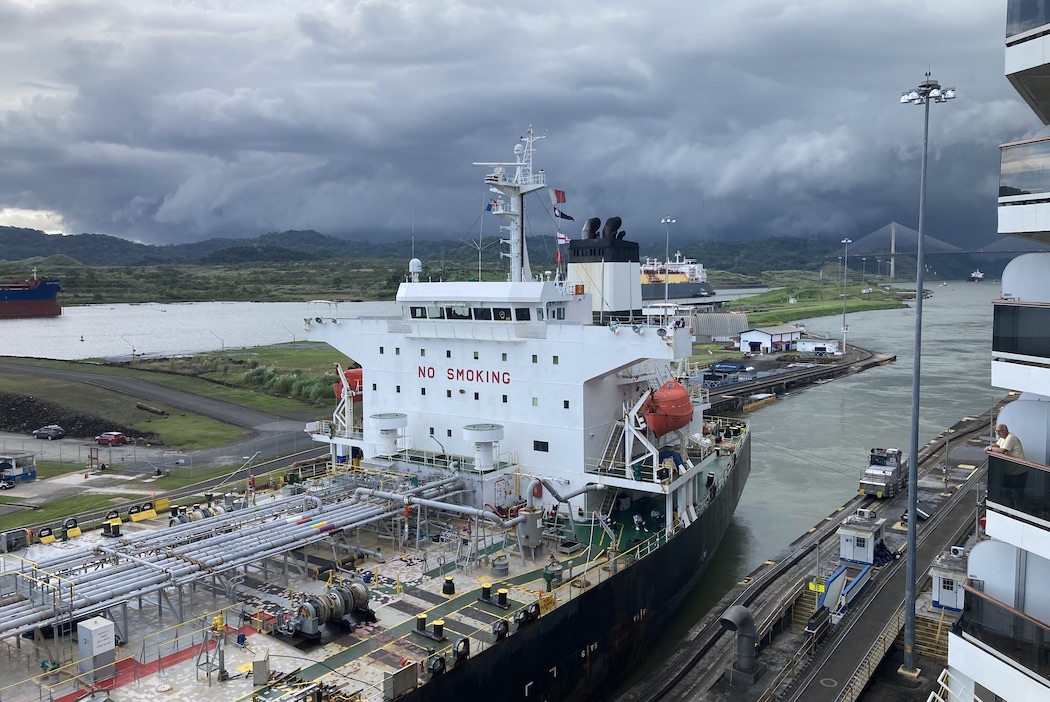
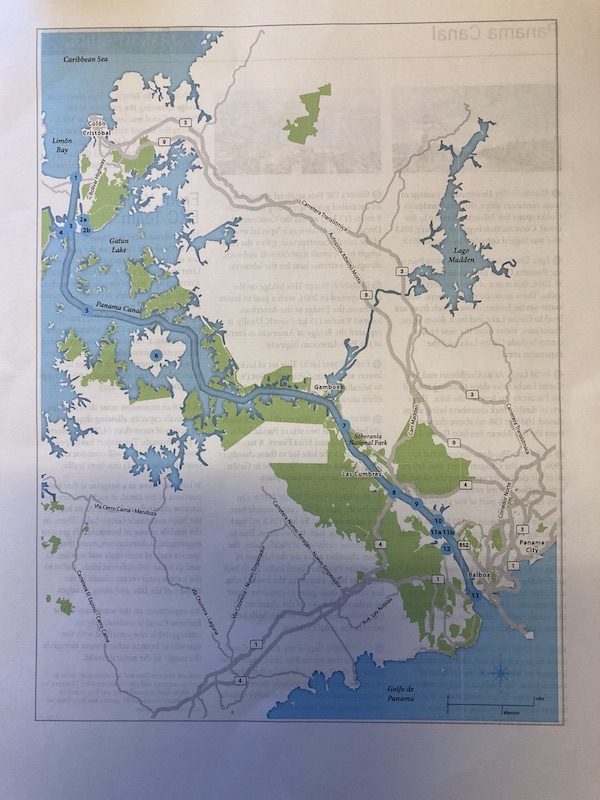
We start this in the Gatun Locks at the Panama Canal, now about 0800.
We continued most of the day through the Gatun Lake (32-34 meters above sea level), the Pedro Miguel Lock, and now (1630) we are just departing the lower Miraflores Lock (above). Technically, we're in the Pacific.
One notable thing was that we did the Team Trivia at noon and WON. We felt we'd done poorly, so the others must have really been baffled. The questions were all on obscure Thanksgiving facts.
It was really hot and humid today, especially in the sun.
Now we'll steam out to the peninsula where the Cruise Terminal lies, with its new dock - lower right corner of the map (R). Still a lot of canal to go.
We"re told it cost HA some $320,000 + a $50,000 special contribution to transit the canal today.
We met with F/D in the Martini Bar at 1830. At 1900 we went to dinner in the MDR. Took a long time to get seated, probably because many people wanted to do the traditional turkey dinner.
Then we did traditional dinners and desserts. At the end we were all tired and ready to retire.
Off to the cabin to download another book and prep for tomorrow.
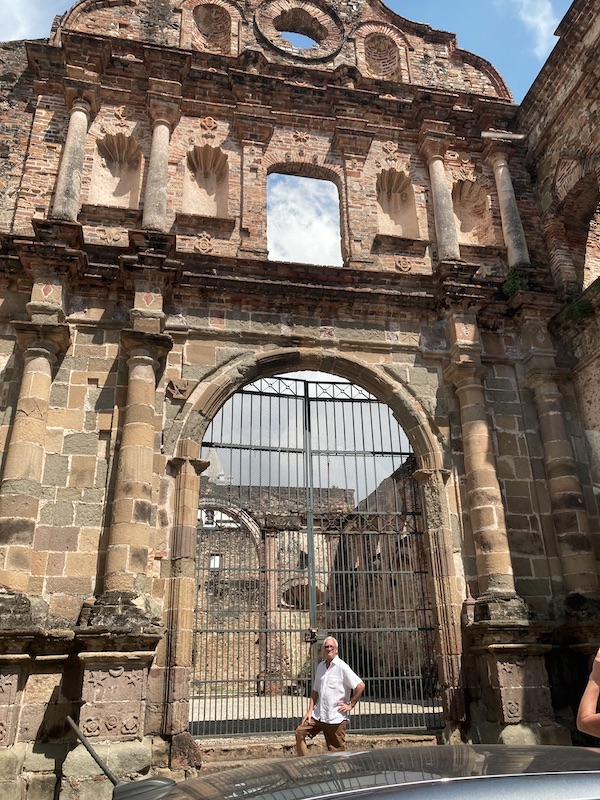
The day started with a huge fight with Oosterdam staff. We were told by paper notice late last evening that persons leaving the ship MUST use the shuttle bus. Then we were told that the first shuttle bus for people not using HA tours would leave at 0930. This was distressing since our tour was to begin at 0900. It gives the impression that HA is favoring their own tours over the ones the customer wants.
Fran didn't find this till this morning, so it put her in the position of rescheduling our tour on very short notice. She was able to do it, but she was angry that she was informed so late.
The terminal here is very much under construction. The roads are dirt. Trucks everywhere. Shuttles run to a hotel parking lot where you can meet your guide, and many were there. But we met AsDRUbal successfully and away we went.
First we went west over the canal on the Bridge of the Americas to a view point of the port and the bridge. O bought a tee-shirt from a vendor while we got a talk on the port being the largest on the Pacific side of South America. Then back over the bridge into the most recent old town, that of the Americans running the canal until it went to Panama. It looked for all the world like a large army base.
He showed us a very poor residential area next, with good commentary on why it is poor. Very sad place. Next we got into the downtown part of the old town (not the old old town), where we saw some Spanish architecture buildings from the 1800's, some refurbished and in current use; also ruins dating back to the 1700's and before. Very narrow streets, good sidewalks for the time of "gardez-loo" however the Spanish said it. He said the streets were laid out when there were two horses in town and traffic has been terrible ever since.
We then drove through a banking district. Asdrubal said Panama's wealth is driven by 1) tourism, 2) banking, 3) shopping, 4) the canal, and 5) the port. Tourism is obvious. People move their money to banks here for the low taxes. People from other countries come here to shop because prices are low with no taxes (average new car $20k). The canal brings in a lot of money, half of which covers maintenance and capital improvement. The port has at least 20 huge cranes unloading containers; some goods are for Panama, other containers are off-loaded and run by rail to Cristobal on the Atlantic to be picked up by nearby countries.
(Skyline of Panama City below)
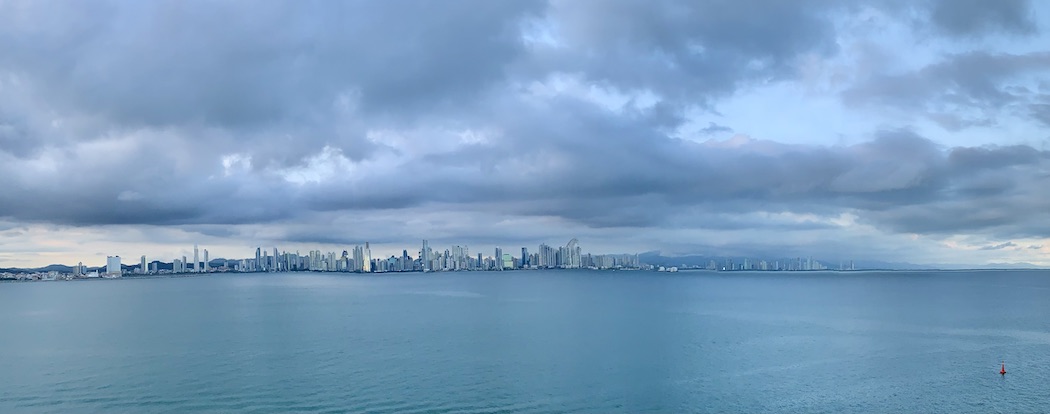
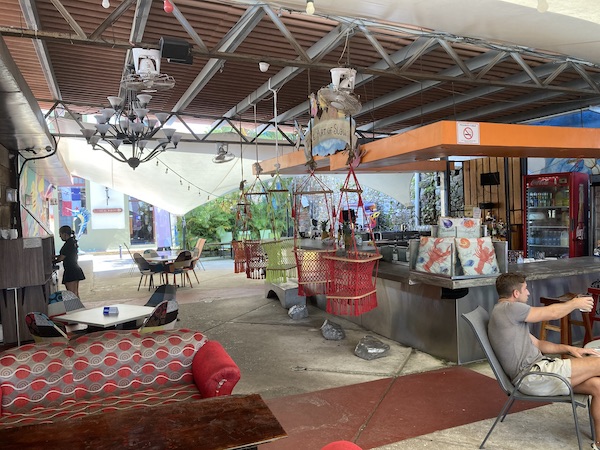
Cars are the mode of transport. There are buses, and there are some e-cars and a few motorcycles, but few bikes and not much incentive for exercise for the four million.
We took a break in a small cafe called Finca del Mer, in view of the ocean but definitely not fancy. We had fish fingers & fries with margaritas, just right for the day and location.
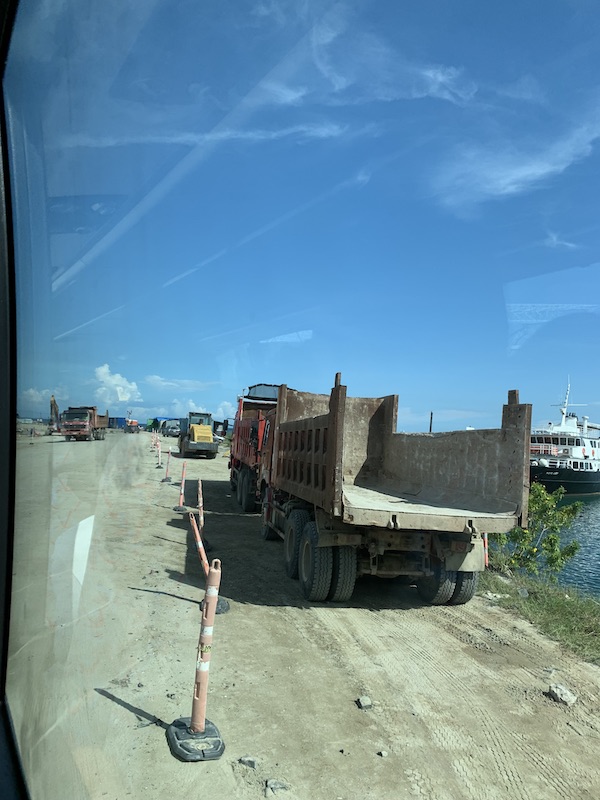
A little farther a bit of stone trail was pointed out to us as part of the original royal trail on which gold was transported over the isthmus to the Atlantic for Spain. Then there was a long area of ruins of the old old town that was sacked by Henry Morgan in 1570. The only thing he didn't destroy was St Joseph's church - the priest said there was no gold there. But the interior doors were gold-plated. When Morgan found out, he took it as a joke on him, gave the priest a few coins, and let the church stay.
It was getting onward by then, so we started back to the meeting point. He took us on an expressway over the bay to the road leading out over four islands to the shuttle lot. Fran tipped him, I tipped her, and we said our thanks.
We then slowly bounced our way to the ship and boarded.
At departure time 1630, word was passed that one cabin's people must verify they were aboard. Apparently, they had not yet returned. Twenty minutes later, we went ahead out of the port. Don't know if those people got back aboard or not.
Photos Link
On to Ecuador - next page.